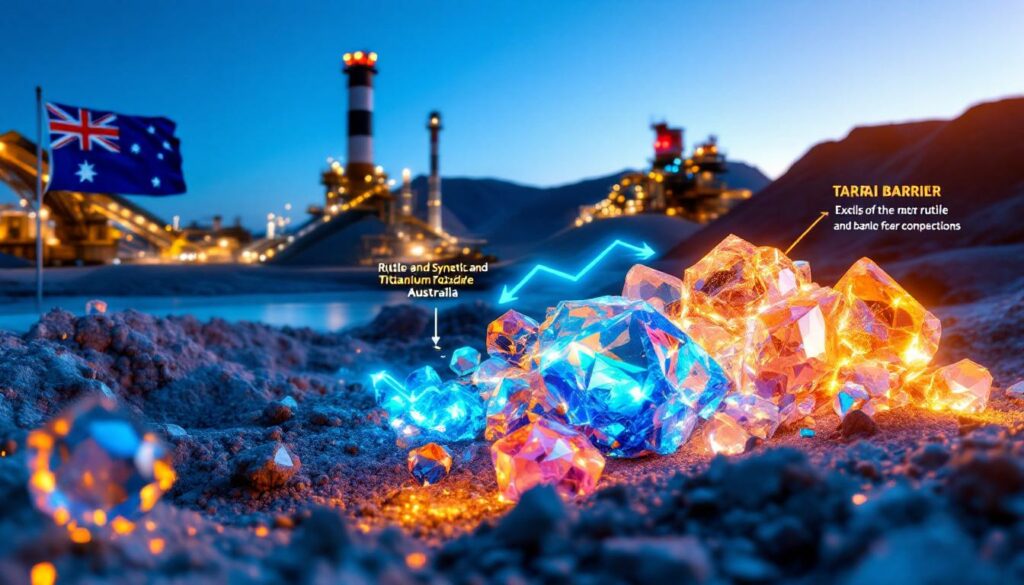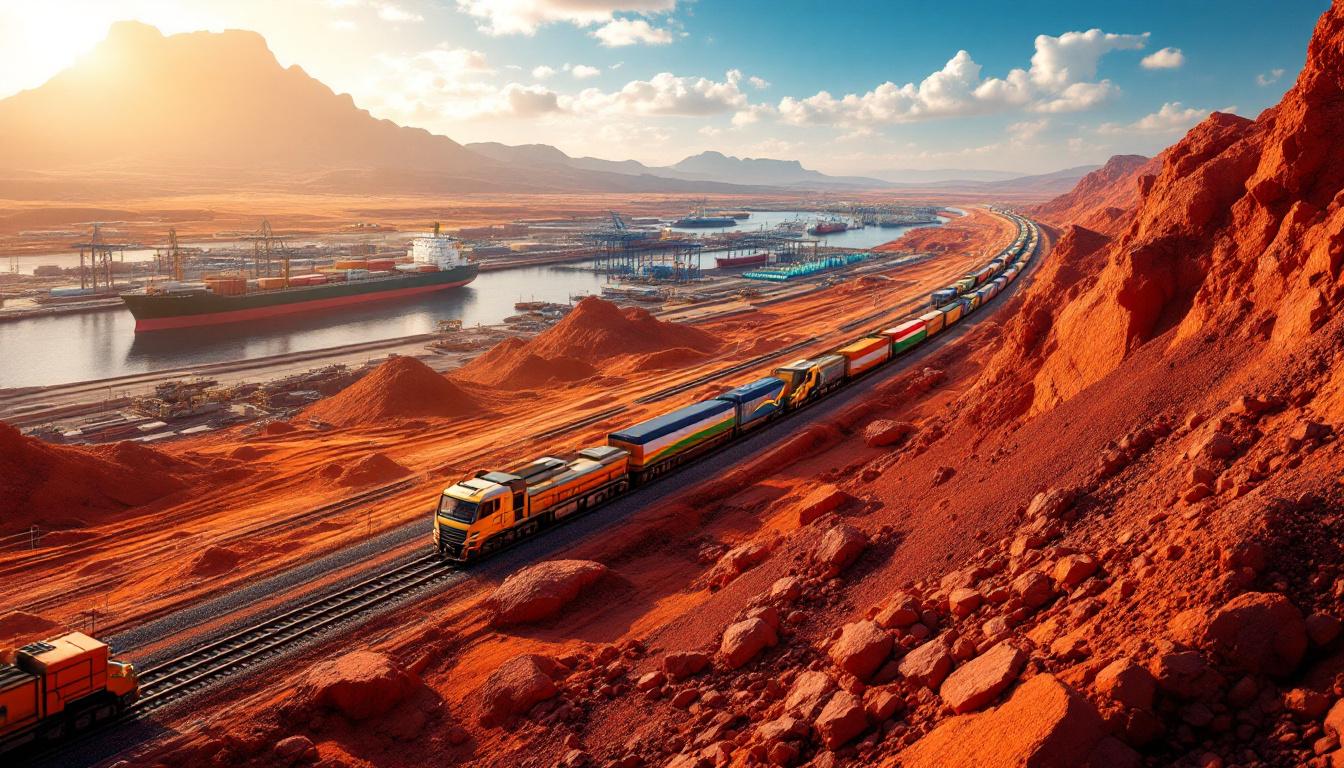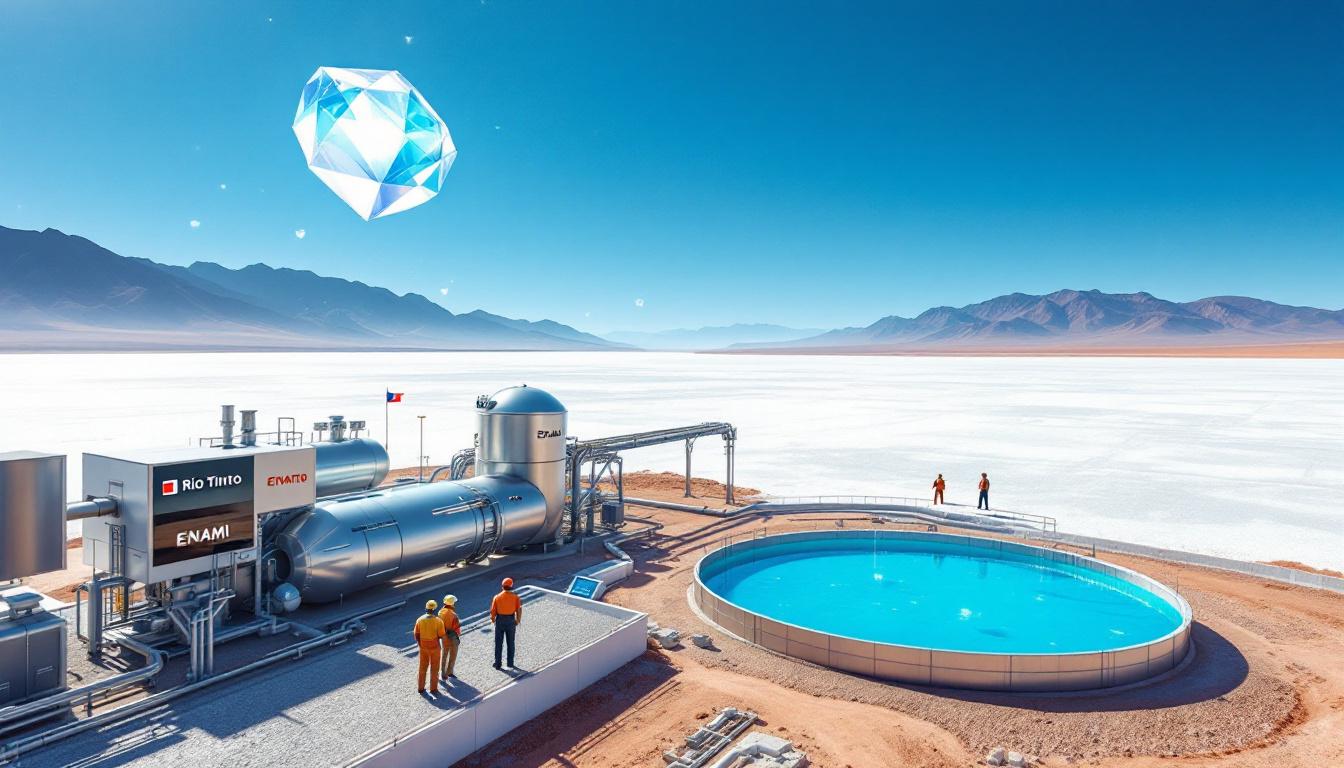Understanding Iluka's Position in the Global Market
Iluka Resources holds a commanding position in the global mineral sands and rare earths sector, with operations strategically concentrated in Australia. The company has established itself as a major producer of zircon, titanium dioxide products (including rutile and synthetic rutile), and rare earth elements. These materials form essential components across diverse industries, from ceramics and electronics to renewable energy technologies and aerospace applications.
With approximately 25% of global zircon production capacity, Iluka stands as one of the world's leading suppliers of this critical mineral. Australia's mineral sands industry, in which Iluka is a dominant player, contributes to about 35% of global titanium feedstocks, according to Geoscience Australia's 2023 assessment. This positions Iluka as a vital link in global supply chains for materials that underpin everyday products and emerging technologies alike.
The company's product portfolio serves highly specialized applications:
- Zircon: Essential for ceramics manufacturing (accounting for 70% of global consumption) and foundry applications
- Titanium dioxide feedstocks: Critical for production of white pigments used in paints, plastics, and paper
- Rare earth elements: Fundamental components in permanent magnets, catalysts, and various high-tech applications
Iluka's vertical integration strategy differentiates it from many competitors, with capabilities spanning mining, processing, and increasingly, refining operations. This approach creates resilience against supply chain disruptions while capturing additional value within secure jurisdictions.
What Production Achievements Did Iluka Report in Q2 2025?
Production Volume Highlights
Iluka's June quarter 2025 demonstrated significant production momentum across its product portfolio. Total production reached 150,000 tonnes, representing a substantial increase of 19,000 tonnes (+14.5%) compared to Q1 2025. This production growth demonstrates the company's operational resilience despite challenging global trade conditions.
Key production metrics by product category reveal strong performance:
| Product | Q2 2025 Production | Change from Q1 | Notes |
|---|---|---|---|
| Total Production | 150,000 tonnes | +19,000 tonnes | 14.5% quarterly growth |
| Zircon Sand | 36,900 tonnes | Increase | Premium and standard grades |
| Zircon-in-Concentrate (ZIC) | 41,700 tonnes | Increase | From various operations |
| Rutile | 13,400 tonnes | Stable | Consistent production |
| Synthetic Rutile | 57,700 tonnes | Increase | SR2 kiln at full capacity |
When compared to historical data, these figures represent approximately 18% growth over Q2 2024 production levels (127,000 tonnes), highlighting Iluka's successful expansion of output despite global economic uncertainties.
Sales Performance
Iluka's sales figures for Q2 2025 demonstrated robust demand across product categories:
| Product | Q2 2025 Sales | Market Indicators |
|---|---|---|
| Zircon Sand (Premium & Standard) | 49,000 tonnes | Strong ceramics demand |
| Synthetic Rutile | 37,000 tonnes | Pigment producer restocking |
| Zircon-in-Concentrate | 42,000 tonnes | Consistent offtake |
| Total Sales | 133,000 tonnes | Solid overall performance |
The gap between production (150,000 tonnes) and sales (133,000 tonnes) indicates strategic inventory management, with the company potentially building buffer stock amid uncertain trade conditions or preparing for anticipated demand increases in subsequent quarters.
How Are US Tariffs Impacting Iluka's Operations?
Current Tariff Structure
Since April 5, 2025, Iluka has navigated an increasingly complex trade environment following the United States' implementation of a baseline 10% tariff on Australian imports. This trade policy shift, documented in the Federal Register (Vol. 90, No. 66), has created a nuanced operational landscape for the company, with varying impacts across its product portfolio:
| Product Category | US Tariff Status | Rationale for Status |
|---|---|---|
| Titanium Dioxide Feedstocks (Rutile & Synthetic Rutile) | Exempt | Strategic materials for US industry |
| Light & Heavy Magnet Rare Earths | Exempt | Critical for defense and high-tech applications |
| Zircon | Subject to 10% Tariff | No strategic exemption granted |
According to Benchmark Mineral Intelligence (July 2025), these tariffs impact on markets could potentially add approximately $50 per tonne in costs for zircon exports to the US market. Given the United States imported around 450,000 tonnes of zircon in 2024 (USITC DataWeb), the impact on the broader market dynamics is significant.
Market Uncertainty and Strategy
The implementation of these tariffs has introduced substantial uncertainty into Iluka's market outlook. As noted in their Quarterly Report: "Tariffs undermine forecast reliability as global trade patterns evolve" (p.3). The company has highlighted several key challenges:
- Disruption to established global trade flows as buyers seek cost-effective alternatives
- Unpredictable downstream economic impacts affecting end-user demand
- Potential reshaping of supply and demand dynamics in regional markets
- Reduced forecast reliability due to policy volatility
"Geopolitical conflicts continue to undermine forecast reliability in mineral sands markets, requiring adaptable strategies and diversified customer relationships." – Iluka Resources, Q2 2025 Report
In response to these challenges, Iluka has adopted a measured approach by:
- Withholding guidance for zircon sales volumes and pricing for Q3 2025
- Maintaining a disciplined market approach rather than pursuing volume at the expense of price
- Exploring alternative markets, particularly in Southeast Asia where ceramics production is growing at approximately 8% year-on-year
- Evaluating selective price adjustments to maintain competitiveness in tariff-affected regions
This approach mirrors successful tariff mitigation strategies employed by other major mining companies, such as Rio Tinto's tariff absorption strategy implemented in 2020 during previous trade tensions.
What Mining Operations Are Supporting Iluka's Production?
Jacinth-Ambrosia Mine (South Australia)
The Jacinth-Ambrosia operation in South Australia continues to perform as a cornerstone asset for Iluka:
- Q2 2025 production: 68,000 tonnes of heavy mineral concentrate (HMC)
- Modest increase from Q1 2025 (66,000 tonnes), representing 3% quarterly growth
- Primarily supplies zircon-rich material with premium grade characteristics
- Reserve life extends beyond 15 years based on current mining rates
The operation employs advanced water management techniques critical for sustainable mining in South Australia's arid environment. Its consistent performance provides Iluka with a reliable source of high-grade zircon that commands premium pricing in international markets.
Cataby Mine (Western Australia)
The Cataby operation in Western Australia experienced planned production variations during the quarter:
- Q2 2025 production: 154,000 tonnes of HMC
- Decrease from Q1 2025 (184,000 tonnes), representing a 16.3% reduction
- Reduction attributed to lower ore grade, though aligned with the mine's 2025-27 planning sequence
- Higher ore volumes processed (increased throughput) partially offset the grade decrease
- Remaining reserve life approximately 7 years at current production rates
The mine's performance highlights the typical variability in mineral sands operations, where grade fluctuations based on ore body characteristics are managed through mining industry evolution and processing adjustments to maintain overall production targets.
Processing Facilities Performance
Iluka's processing operations demonstrated robust performance throughout the quarter:
- Total HMC processed in Q2: 201,000 tonnes
- Narngulu mineral separation plant processed 124,000 tonnes of HMC
- Production included 79,000 tonnes of zircon products and 13,000 tonnes of rutile
- SR2 kiln operated at full capacity, producing 58,000 tonnes of synthetic rutile
These processing facilities represent a critical competitive advantage for Iluka, allowing the company to transform raw mineral concentrates into higher-value finished products that command premium pricing and serve specialized customer requirements.
What Strategic Projects Is Iluka Advancing Despite Tariff Challenges?
Eneabba Rare Earths Refinery (Western Australia)
The Eneabba project represents Iluka's most significant strategic initiative, positioning the company at the forefront of critical minerals in energy transition:
- Designed to become Australia's first fully integrated rare earth oxides refinery
- Laboratory construction progressing with specialized equipment arriving on site
- Will produce separated light and heavy rare earth oxides through advanced solvent extraction technology
- Planned annual production capacity of 20,000 tonnes of Total Rare Earth Oxides (TREO)
- Key outputs will include approximately 700 tonnes of dysprosium and other heavy rare earths
- Construction workforce exceeds 300 personnel according to WA Government project tracking
The facility will process monazite feedstock to produce rare earth oxides essential for permanent magnets used in electric vehicles, wind turbines, and advanced electronics. With dysprosium currently trading at approximately $350/kg (Argus Metals, July 2025), this represents a significant value-adding opportunity.
"The Eneabba project positions Iluka strategically in critical minerals supply chains at a time when secure, sustainable sources of rare earths are increasingly prioritized by governments and manufacturers worldwide."
Balranald Resource Development (New South Wales)
The Balranald project continues to advance according to schedule, representing an innovative approach to accessing deep mineral sands deposits:
- Construction works progressing as planned toward H2 2025 commissioning
- Stope development underway for Stope 1 (first stage of underground mining)
- Employs long-hole stoping mining method, adapting underground mining techniques to mineral sands extraction
- Will expand Iluka's mineral sands production capacity with high-grade rutile and zircon
This project demonstrates Iluka's technical innovation, applying underground mining methods traditionally used in hard rock mining to access deep mineral sands deposits that would be uneconomical to recover through conventional open-pit methods.
How Is Iluka Positioning for Future Market Conditions?
Strategic Flexibility
Despite market uncertainties introduced by shifting trade policies, Iluka and global tariffs impact on its strategic flexibility is being managed through a multi-faceted approach:
- Disciplined market positioning: Prioritizing sustainable pricing over volume-driven strategies
- Operational adaptability: Maintaining ability to adjust production volumes based on market conditions
- Continued strategic investment: Advancing key projects despite short-term market challenges
- Diversification strategy: Expanding rare earths capabilities to reduce reliance on traditional mineral sands markets
This approach enables Iluka to navigate current market uncertainties while positioning for long-term growth. The company's vertical integration strategy potentially delivers approximately 20% cost reduction compared to outsourcing processing operations, according to sector analysis by Adamas Intelligence.
Long-Term Market Outlook
While short-term market conditions remain challenging due to trade policy uncertainty, several fundamental factors support Iluka's long-term outlook:
- Growing rare earths demand: Projected to reach 200,000 tonnes annually by 2040 (IEA Critical Minerals Outlook 2024), driven by clean energy transition
- Strategic minerals prioritization: Increasing government focus on secure supply chains for critical minerals
- Australia's geopolitical positioning: Recognized as a reliable supplier in an increasingly uncertain global environment
- Vertical integration advantages: Reduced exposure to processing bottlenecks and third-party margin capture
The company's strategic investments in rare earths processing particularly aligns with major policy initiatives like the EU Critical Raw Materials Facility, which establishes specific import targets for responsibly sourced critical minerals from reliable partners.
What Are the Broader Implications of Trade Policies on Mining Companies?
Evolving Global Trade Patterns
The current trade environment highlights several important trends affecting mining companies globally:
- Rising protectionism: Over 78 new trade measures affecting critical minerals implemented since 2020 (Global Trade Alert)
- Supply chain regionalization: Accelerating development of regional mineral processing hubs
- Strategic exemptions: Increasing use of carve-outs for minerals deemed critical to national security
- Bilateral agreements: Rise of country-to-country arrangements like the Australia-US Critical Minerals Agreement (signed January 2025)
"Tariffs accelerate regional supply chain development as companies seek to minimize cross-border friction points." – IMF Working Paper WP/25/96
These evolving patterns create both challenges and opportunities for mining companies with global mining landscape operations and customer bases.
Strategic Responses for Mining Companies
Companies in the mining sector are adapting to these challenges through sophisticated strategies:
- Geographic diversification: Establishing customer relationships across multiple regions to mitigate region-specific policy risks
- Vertical integration: Capturing more value within secure jurisdictions through expanded processing capabilities
- Product specialization: Focusing on materials exempt from tariffs or subject to strategic necessity exceptions
- Enhanced market intelligence: Developing robust capacity to anticipate policy shifts and adapt rapidly
- Strategic partnerships: Forming alliances with downstream customers to secure offtake regardless of trade barriers
Mining companies are also increasingly engaging with governments on critical minerals strategies, recognizing the growing intersection between commercial interests and national security priorities in this sector.
FAQ: Iluka Resources and Global Tariffs
How significant is the US market for Iluka's zircon products?
The US represents an important market for Iluka's zircon products, particularly in ceramics manufacturing and foundry applications. With the US importing approximately 450,000 tonnes of zircon in 2024 (USITC DataWeb), the 10% tariff increases costs for US customers and potentially impacts Iluka's competitive position against suppliers from non-tariffed countries.
Why are some of Iluka's products exempt from US tariffs?
Titanium dioxide feedstocks and rare earth elements are exempt due to their classification as strategic materials essential for US industry, defense, and high-technology applications. These exemptions reflect growing recognition of certain minerals as critical to national security and industrial policy, as formalized in the USTR's tariff exemption list (Annex B).
How might tariffs affect Iluka's rare earths strategy?
The tariff exemption for rare earths actually strengthens Iluka's strategic focus on developing its rare earths capabilities. These products can enter the US market without additional tariff costs, potentially offering more stable revenue streams than tariffed products. This policy environment further validates Iluka's substantial investment in the Eneabba rare earths refinery.
What options does Iluka have to mitigate tariff impacts?
Iluka can explore several strategies to address tariff challenges, including:
- Redirecting zircon sales to growth markets in Southeast Asia, where ceramics production is expanding at approximately 8% annually
- Negotiating with customers to share tariff costs based on market conditions and competitive dynamics
- Accelerating development of exempt products like rare earths to diversify revenue streams
- Engaging with both Australian and US governments through industry associations to advocate for expanded exemptions
The effectiveness of these strategies will depend on broader market conditions and the duration of current trade policies.
Ready to Spot the Next Major Mineral Discovery?
Discover why historic ASX mining discoveries can generate substantial returns by visiting Discovery Alert's dedicated discoveries page, where our proprietary Discovery IQ model translates complex mineral data into actionable investment opportunities for both short-term traders and long-term investors.




